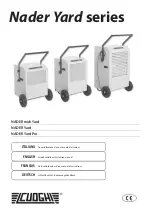
FIGURE 1
DANGER
The following types of installation sites (but not limited
to the following) will require OUTDOOR AIR for
combustion because of chemical exposures: commercial
buildings, buildings with indoor swimming pools,
furnaces installed in laundry rooms, furnaces in hobby
or craft rooms, furnaces installed near chemical storage
areas.
Direct Venting Pipe Connections
(USING OUTDOOR COMBUSTION AIR)
The direct vent configuration is the preferred instal-
lation method. The primary advantages are:
•
Dedicated combustion air and vent piping elimi-
nates the need to use already heated air for
combustion purposes
•
The probability of corrosive contaminants being
present in the combustion air is greatly reduced
•
The direct vent configuration is unaffected by
any other appliances, exhaust fans, or other
devices that tend to create negative pressure
conditions while operating
•
No vents for combustion and ventilation air are
required in confined spaces
CAUTION
Combustion air must be free of acid forming chemicals
such as sulphur, fluorine and chlorine. These elements
are found in aerosol sprays, detergents, bleaches,
cleaning solvents, air fresheners, paint and varnish
removers, refrigerants, and many other commercial and
household products.
When burned in a gas flame, vapors from these products
form acid compounds. Acid compounds increase the dew
point temperature of the flue products and are highly
corrosive after they condense.
Any furnace failure caused by corrosive elements is
excluded from warranty coverage.
Exposure to the following substances in the combustion
air supply (but not limited to the following) will also
require OUTDOOR AIR for combustion:
• Aerosols, particularly CFC based or propelled aerosols
• Air fresheners
• Airplane Glue and similar adhesives and cements
• Ammonia, as commonly found in permanent wave
solutions used in hair dressing salons
• Antistatic fabric softeners used in clothes dryers
• Carbon tetrachloride
• Chlorinated cleaners and waxes
• Chlorine and bromine based swimming pool chemicals
• Deicing salts or chemicals, e.g. rock salt, etc.
• Dry cleaning fluids such as perchloroethylene
• Fumes from curing polyurethane and similar
substances
• Halogen based refrigerants including R-12 and R-22
• Hydrochloric acid, muriatic acid and other acid based
masonry washing and curing materials
• Printer’s inks, paint removers, varnishes, varsol,
toluene, etc.
• Water softener salt and chemicals
The supplied adapter is made of PVC. If planning to
use ABS pipe, use an all-purpose cleaner and ABS to
PVC transition cement. If planning to use CPVC pipe,
use an all-purpose cleaner, a clear or purple primer
and all-purpose cement approved for the purpose.
Additional information about cleaners, primers, sol-
vents and cements may be obtained from their manu-
facturers.
IMPORTANT
The combustion air piping, like the exhaust piping, must be
air tight throughout the system. The adapter joining the
combustion air to the furnace is supplied with a gasket to
maintain the seal.
FURNACE VENTING
AIR FOR PROPER COMBUSTION AND VENTILATION OF
THIS FURNACE AND ANY OTHER FUEL BURNING
APPLIANCE MUST BE PROVIDED WITH ENOUGH FRESH
THE FLUE GASES. MOST HOMES WILL REQUIRE THA
OUTSIDE AIR BE BROUGHT TO THE FURNACE AREA.
FAILURE TO DO SO CAN CAUSE PERSONAL INJURY OR
DEATH FROM CARBON MONOXIDE POISONING.
READ, UNDERSTAND AND FOLLOW ALL INSTRUCTIONS
IN THIS SECTION. FAILURE TO PROPERLY VENT OR
SUPPLY COMBUSTION AIR TO THIS FURNACE CAN
CAUSE CARBON MONOXIDE POISONING, OR AN
EXPLOSION OR FIRE, RESULTING IN PROPERTY DAMAGE,
PERSONAL INJURY OR LOSS OF LIFE.
DANGER
DANGER
DANGER
DANGER
This furnace is certified as a Category I Type FSP Non-
Direct and Direct Vent Furnace. When installed as a direct
Combustion Air Inlet Piping
vent furnace, all combustion air is supplied from the out-
doors via the plastic piping system. All components are
field supplied except for the adapter used to connect the
piping to the furnace.
14
Содержание operation and
Страница 42: ......
















































